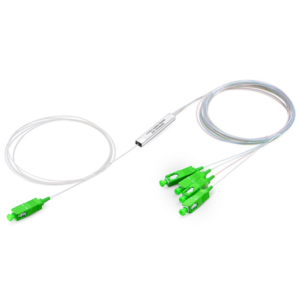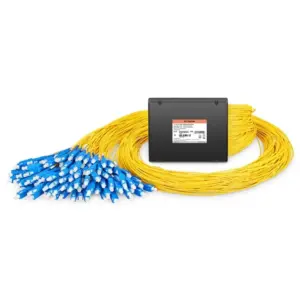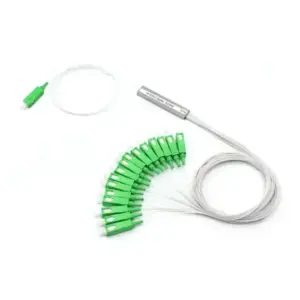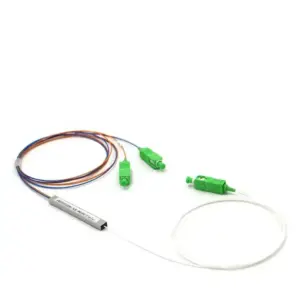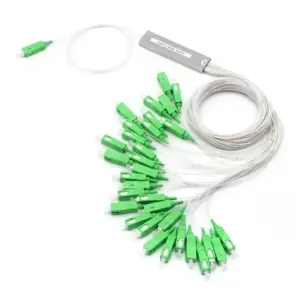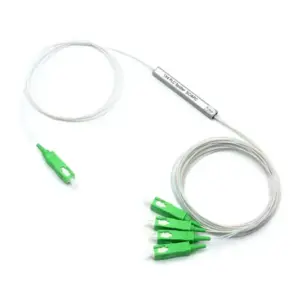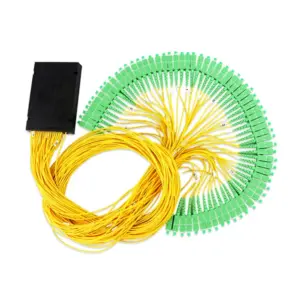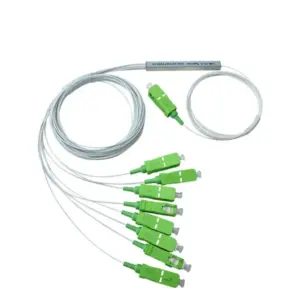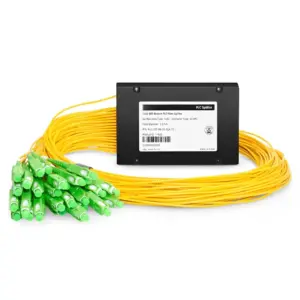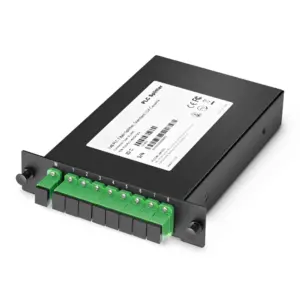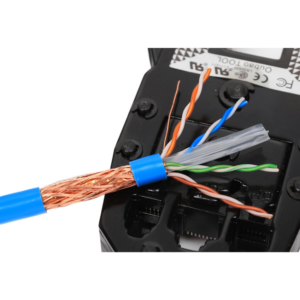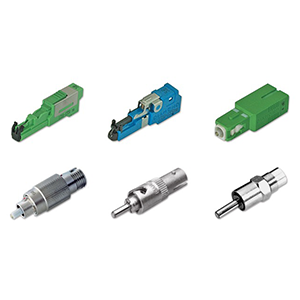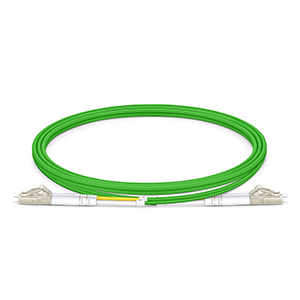1×4 PLC fiber optic splitter, as a key technology in the field of optical communications, brings you an unprecedented connection experience. In this article, I will take you deep into the basics of the 1×4 PLC fiber optic splitter, explaining its basic definition, structure, and similarities and differences with other types of fiber optic splitters.
We will conduct an in-depth analysis of the technical performance of 1×4 PLC fiber optic splitter in optical signal transmission, focusing on its advantages in splitting ratio and insertion loss. By discussing the application scenarios of 1×4 PLC optical fiber splitter in optical communication systems and sharing actual cases, it demonstrates its successful application experience in optical networks.
I. Basic knowledge of 1×4 PLC fiber splitter
Basic definition and structure:
1×4 represents the port configuration of the optical fiber splitter. Among them, “1” means one input port, and “4” means there are four output ports. Therefore, the 1×4 PLC fiber optic splitter has a structure of one input port and four output ports.
Structurally, it includes an input optical fiber port to introduce the input optical signal, and four output optical fiber ports to output the distributed optical signal. Planar waveguide chip technology is used internally to distribute the input optical signal to four output channels through couplers.
Similarities and differences with other types of fiber optic splitters:
-
Comparison with 1×2 optical fiber splitter: 1×2 optical splitter has only two output ports, while 1×4 optical splitter has four output ports. This means that 1×4 can distribute optical signals to more channels, which is suitable for scenarios where optical signals need to be distributed to multiple destinations.
-
Comparison with other multi-channel optical splitters: Compared with other multiplex optical splitters (such as 1×8, 1×16, etc.), the 1×4 optical splitter has fewer output channels and is suitable for situations where fewer output channels are required.
In general, 1×4 PLC optical fiber splitter has certain flexibility in distributing optical signals, and is also suitable for certain specific optical network configurations because of its limited number of output ports.
II. Technical performance and advantage analysis
Technical Performance Analysis:
-
Splitting ratio: 1×4 PLC optical fiber splitter can distribute an input optical signal to four output channels, achieving effective distribution and sharing of optical signals.
-
Wavelength range: It has the characteristics of a wide wavelength range and can support the transmission of optical signals of multiple wavelengths.
-
Insertion loss: The insertion loss of 1×4 PLC fiber optic splitter is usually low, which can ensure the transmission efficiency and stability of optical signals.
-
Cross-coupling: It can effectively reduce cross-coupling between different output channels and ensure the purity and stability of optical signals.
Advantage Analysis:
-
High splitting ratio: The 1×4 PLC optical fiber splitter has the characteristics of high splitting ratio, which can evenly distribute the input optical signal to the four output channels to meet the optical signal needs of different destinations.
-
Low insertion loss: Insertion loss is usually low, ensuring the transmission efficiency and stability of optical signals and reducing the overall loss of the optical communication system.
-
Stability and reliability: The 1×4 PLC fiber optic splitter adopts high-quality materials and precision manufacturing technology, has good stability and reliability, and is suitable for long-term operation and applications under various environmental conditions.
-
Compact structure: It has a compact structure design, small size, easy integration and layout, and is suitable for the construction and application of high-density optical fiber networks.
1×4 PLC optical fiber splitter plays an important role in optical communication systems. Its excellent technical performance and stable operating characteristics provide an effective solution for the distribution and transmission of optical signals.
III. Application scenarios and actual cases
Application scenarios:
-
FTTx: In access networks such as FTTH and FTTB, 1×4 PLC fiber optic splitters are used to distribute optical signals to different user terminals or buildings.
-
Fiber optic sensing network: 1×4 PLC fiber optic splitter plays an important role in the fiber optic sensing network. It is used to distribute optical signals to different sensing units and monitor physical quantities such as temperature, pressure, strain, etc.
-
Data center: In the optical interconnection of the data center, 1×4 PLC optical fiber splitter is used to realize data distribution and integration, improving the efficiency and reliability of data transmission.
-
Cable TV network: In the cable TV network, 1×4 PLC optical fiber splitter is used to distribute optical signals to different user terminals to realize the transmission and distribution of cable TV signals.
Actual case:
-
Urban fiber optic network: In the deployment of urban fiber optic networks, 1×4 PLC fiber optic splitters are widely used in signal distribution and integration, improving the coverage and transmission efficiency of urban communication networks.
-
Medical field: In medical equipment and medical information systems, 1×4 PLC fiber optic splitters are used to realize the distribution and transmission of optical signals and support the efficient transmission and processing of medical data.
-
Industrial automation: In industrial control systems and automated production lines, 1×4 PLC optical fiber splitters are used for the distribution and transmission of optical signals, achieving real-time monitoring and control of industrial data.
These actual cases demonstrate the successful application experience of 1×4 PLC optical fiber splitter in optical networks, providing reliable optical distribution solutions for various optical communication systems and application scenarios.
IV. Practical Advice on Deployment and Maintenance
Selection and deployment recommendations:
-
Requirements analysis: Before selecting a 1×4 PLC fiber optic splitter, a full demand analysis must be conducted first, including requirements in terms of splitting ratio, wavelength range, insertion loss, etc.
-
Brand and quality: Choose well-known brands and suppliers with reliable quality to ensure the stability and performance of the device.
-
Environmental adaptability: Consider the characteristics of the deployment environment and select devices suitable for different operating temperatures, humidity and other environmental conditions.
-
Layout and installation: Design a reasonable layout plan based on actual needs, ensure that the connection and wiring of optical fibers comply with optical specifications, and pay attention to avoid bending and stretching of optical fibers.
Best Maintenance and Precautions:
-
Regular inspection: Regularly check the fiber connection to ensure that the connection port is clean and dust-free, and that the optical fiber is not damaged or bent.
-
Cleaning and maintenance: Clean the optical fiber connectors and interfaces regularly to avoid the impact of dust, grease and other contaminants on optical signal transmission.
-
Dust-proof and moisture-proof: Ensure that the equipment and fiber optic connection ports are in a dry and ventilated environment to avoid the impact of dust and moisture on the equipment.
-
Avoid overstretching: Avoid overstretching the fiber to avoid damaging the fiber connector or connector.
-
Regular calibration: Regularly calibrate and debug the fiber optic splitter to ensure its performance and stability.
-
Backup and replacement: Back up key data and configuration information, and replace aging or damaged devices in a timely manner to ensure reliable operation of the system.
By following these practical suggestions and precautions, you can effectively select, deploy and maintain 1×4 PLC fiber optic splitters to ensure the stable operation and long-term performance of your optical communication system.
V. Future trends and development directions
High performance and low loss:
-
Higher splitting ratio: In the future, 1×4 PLC optical fiber splitter may achieve a higher splitting ratio to meet the needs of complex optical networks and improve the transmission efficiency of optical signals.
-
Reducing insertion loss: Continuously optimize the device structure and manufacturing process to reduce insertion loss and improve the transmission quality and stability of optical signals.
Wide wavelength and multi-mode:
-
Wide wavelength range: Future 1×4 PLC fiber optic splitters may support optical signal transmission within a wider wavelength range, adapting to the needs of optical communication systems and optical networks of different wavelengths.
-
Multi-mode support: In addition to single-mode optical fiber, future 1×4 PLC optical fiber splitters may support optical signal distribution of multi-mode optical fiber to adapt to the needs of different optical fiber networks.
Miniaturization and integration:
-
Miniaturization trend: Future 1×4 PLC optical fiber splitters may tend to be miniaturized and integrated, achieving smaller size and higher integration devices to meet the needs of high-density integration and layout.
-
Multi-function integration: 1×4 PLC optical fiber splitter may integrate other functional modules, such as optical modulators, optical switches, etc., to achieve multi-function integration and improve the overall performance and flexibility of the device.
New materials and manufacturing processes:
-
New material applications: Future 1×4 PLC optical fiber splitters may use new materials, such as silicon-based photonics materials, silicon nitride, etc., to improve the performance and reliability of the device.
-
Advanced manufacturing technology: New manufacturing technology and processing technology will continue to be applied in the manufacturing of 1×4 PLC fiber splitters to achieve more precise device structures and more efficient production processes.
To sum up, in the future, 1×4 PLC fiber optic splitters will continue to innovate and develop in terms of performance, miniaturization, and multi-wavelength support to meet the growing demand for optical communications market and promote the progress and development of optical communications technology.
Summary:
1×4 PLC optical fiber splitter is not only a pioneer in the field of optical communications, but also a bridge connecting the world. Its excellent technical performance and advantages in optical signal transmission make it a leader in the industry. In the future, with the continuous innovation and development of 1×4 PLC fiber optic splitter technology and its potential role in emerging communication technologies and applications, we believe that it will continue to lead the development trend of optical communication technology.
By choosing our products, you not only gain technological leadership, but also receive support and services from a professional team. Let us work together to create a brilliant future for optical communications and inject new vitality and power into your business and projects!
-
128-channel optical fiber PLC splitter
-
16-channel optical fiber PLC splitter
-
2-way optical fiber PLC splitter
-
32-channel optical fiber PLC splitter
-
4-way optical fiber PLC splitter
-
64-channel optical fiber PLC splitter
-
8-channel optical fiber PLC splitter
-
ABS module PLC fiber optic splitter
-
Box PLC optical fiber splitter

